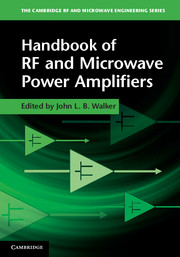Book contents
- Frontmatter
- Contents
- Contributors
- Preface
- 1 Silicon LDMOS and VDMOS transistors
- 2 GaAs FETs – physics, design, and models
- 3 Wide band gap transistors – SiC and GaN – physics, design and models
- 4 Amplifier classes, A to S
- 5 Computer-aided design of power amplifiers
- 6 Practical HF/VHF/UHF RF power amplifier realization
- 7 Microwave hybrid amplifier realization
- 8 Monolithic power amplifiers
- 9 RF power amplifier thermal design
- 10 Reliability
- 11 Power amplifier applications
- 12 Amplifier measurements
- About the authors
- Index
- References
1 - Silicon LDMOS and VDMOS transistors
Physics, design, and technology
Published online by Cambridge University Press: 05 November 2011
- Frontmatter
- Contents
- Contributors
- Preface
- 1 Silicon LDMOS and VDMOS transistors
- 2 GaAs FETs – physics, design, and models
- 3 Wide band gap transistors – SiC and GaN – physics, design and models
- 4 Amplifier classes, A to S
- 5 Computer-aided design of power amplifiers
- 6 Practical HF/VHF/UHF RF power amplifier realization
- 7 Microwave hybrid amplifier realization
- 8 Monolithic power amplifiers
- 9 RF power amplifier thermal design
- 10 Reliability
- 11 Power amplifier applications
- 12 Amplifier measurements
- About the authors
- Index
- References
Summary
Introduction/history
Power amplifiers are at the core of nearly all high-power (i.e., >5 W) RF applications. The application space includes cellular phone basestation transceiver systems, pulsed radar, ISM (industrial, scientific, medical), avionics, digital television broadcast, etc. This diverse and evolving RF power amplifier landscape dictates the strategy for the design, fabrication, and optimization of multiple generations of RF power devices. The RF power transistor must satisfy a broad and often conflicting set of application requirements, including but not limited to power, linearity, efficiency, gain, reliability, thermal management, bandwidth, ruggedness, digital predistortion (DPD) linearizability, and cost effectiveness. The amplifier architecture has also evolved to adapt to the ever-changing system requirements, most recently with the widespread adoption of Doherty amplifiers to boost back-off efficiency in linear applications. These architectural evolutions create opportunities for further refinements in the RF power transistor to extract peak performance from the architecture.
The various major market segments of the RF power market tend to embrace a dominant device technology that meets a broad range of these requirements until a new technology emerges to offer a more compelling solution. Through the late 1970s, silicon bipolar transistors were the preferred RF power device technology [1–2]. The relatively low frequencies and amplifier requirements of the era were compatible with silicon bipolar transistor technology, which was capable of providing a robust, cost-effective solution. The bipolar transistors had adequate gain and efficiency, could be readily scaled to achieve the desired power levels, and offered linearity that was consistent with the modest requirements of that era. On the other hand, power gain was relatively poor, packages with isolated flanges were expensive, thermal runaway due to the negative temperature coefficient had to be carefully managed (usually at the expense of degraded performance because of the need to incorporate ballast resistors), and the evolving and increasingly more stringent linearity and efficiency requirements were becoming difficult to design into the transistors.
- Type
- Chapter
- Information
- Handbook of RF and Microwave Power Amplifiers , pp. 1 - 41Publisher: Cambridge University PressPrint publication year: 2011
References
- 2
- Cited by

